Whatever your opinion of The Last Jedi (count me among those agreeing with Jeremiah), one thing the majority agree on is how different it was from the rest of Star Wars. A far cry from the way The Force Awakens took too much inspiration from A New Hope, The Last Jedi avoids copying The Empire Strikes Back or any other movie almost entirely. It seemed to even enjoy setting up scenarios similar to other Star Wars movies and then delivering its own spin.
Perhaps that’s because Rian Johnson was too busy taking inspiration from another source: the amazing Avatar: The Last Airbender (ATLA).
I know, I know, what in the world am I talking about? Hear me out! Once you see what I’m talking about you won’t be able to unsee it. Why would you want to? The Last Airbender rocks and the inspiration made The Last Jedi better. Now to be clear, I’m not saying it copied it entirely. Rian was smarter than that. Instead, I say it took key inspiration from a select few episodes we’ll cover here, with a bonus inspiration and possible future courtesy of The Legend of Korra (LoK).
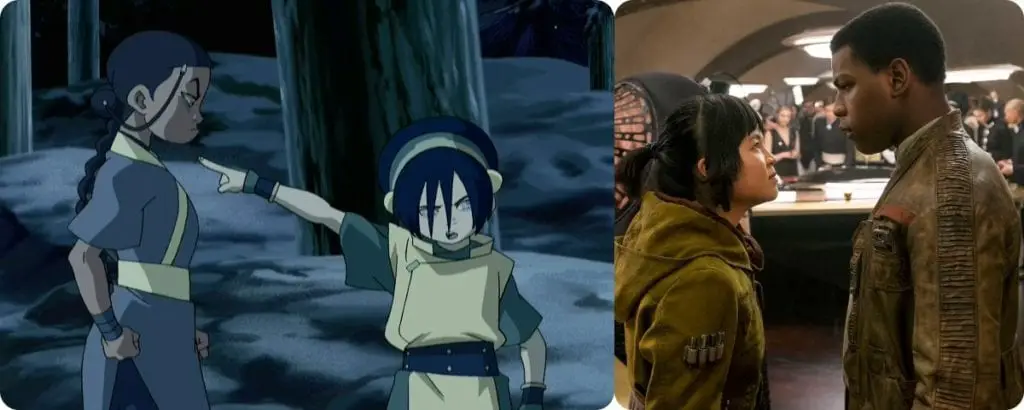
“The Chase”
This one is incredibly obvious. “The Chase” sees an exhausted Aang, Katara, Toph, and Sokka trying to stay one step ahead of Azula, Ty Lee, and Mai, who spend the episode in hot pursuit. Over the course of the episode, stress and lack of sleep leads to infighting between the pursued, a headstrong and rebellious member fighting with the female leader before eventually running off, a failed attempt by one person to create a false trail, and a desperate final stand fight.
Huh, sounds familiar, doesn’t it?
The most obvious similarity is in the concept, of course. The entire plot of both this episode and The Last Jedi revolves around the good guys running from the bad guys and never quite being able to lose them. It’s a simple concept fraught with potential for character interaction, and both “The Chase” and The Last Jedi take advantage of it.
Holdo fills in for Katara as the mature leader trying to keep her group under control and combating with Poe. She also takes Aang’s place in attempting a distraction to let the others slip away unseen. Poe and Finn share Toph duty; Poe plays the rebellious leader arguing with Katara/Holdo, while Finn gets to run away.
In a twist, however, Luke steps in for Azula as the focus of an overwhelming barrage to survive during the climax. Bold move, Star Wars.
Okay, I know this one is a bit of a stretch. The concept of good guys running from bad guys can be found anywhere. Despite the similarities in the two chases and the reactions the chases elicit, I might believe Rian Johnson didn’t watch ATLA if this was the only comparison.
Oh, but we’re nowhere close to done yet.
“The Drill”
You did see the giant space laser drill that breaks down the walls of Ba Sing Se, right?
Besides that, the similarities involve many of the same similarities from “The Chase”, but in different context. “The Drill” sees Azula and the Fire Nation bring a giant drill tank to tear down the outer wall of Ba Sing Se. Aang and company are left to find some way to stop the massive contraption before it succeeds. In the end, they succeed at the last second.
The Last Jedi pulled double duty inspiration from both “The Chase” and “The Drill” with its movie-long chase. Where it reminded of “The Chase” in the idea of good guys running from bad guys and the stress caused as a result, comparisons to “The Drill” are both less literal but more accurate. Both the episode and movie use the concept of a time limit for the good guys to find some way to stop the bad guys. Okay, fine, I again admit this is nothing new. Could be pure coincidence.
Except, you know, the way The Last Jedi ends up having its heroes attempt to stop the First Order and eventually succeed.
Remember how Finn and Rose infiltrated Snoke’s ship to sabotage it from the inside? Sure felt a lot like the Gaang doing the same inside the drill. How about the eventual climactic fights between Aang/Azula and Luke/Kylo? Both involve the good guy using the aggression of the villain against them in order to succeed.
You can even take a look at the comparisons between Aang and Luke; not just in this fight, but the movie as a whole. The Last Jedi’s Luke Skywalker is basically Avatar Aang. He spends long years hiding away in the aftermath of a mistake and blames himself for the current rise of an imperial power. He chooses to evade and avoid rather than face the consequences of his actions head on. The same way the three Nations struggling against the Fire Nation look desperately to Avatar Aang as a symbol of resistance and hope, even continuing to hold out hope after one-hundred years, Leia and her Rebellion look at Luke the same and hold out the same hope.
I can go on, and will later. Those further points are not quite related to “The Drill” though, so I won’t include them here.
I know, so what? Like with “The Chase”, many of these similarities are natural. Even combined they don’t prove anything. You need me to go on? I’ll be glad to. We haven’t even hit the meat of the comparison.
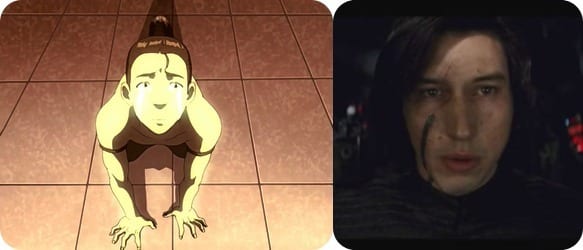
“The Storm”
Now we’re getting somewhere. While not quite the episode that drew me in to ATLA for good (that would be the two-part “Winter Solstice”), “The Storm” was the one that made clear what ATLA was capable of. Aang and Zuko’s pasts were explored to compare and contrast the main hero and (then) villain of the story and make clear the importance of their relationship to the future of the show.
Which, of course, it was THE main relationship of the show. Zuko’s pursuit of Aang and the journey caused by reflection of his support really defines the majority of what happens. Kind of like…Rey and Kylo!
There should be absolutely no question left after The Last Jedi that the relationship between Rey and Kylo Ren is driving the story. Their connection and struggles to turn each other made for the meat of The Last Jedi and determined the climax and ending of the movie. They are the two central figures of the Star Wars film franchise now. Just like “The Storm” introduced us to the importance of Aang and Zuko’s dynamic, The Last Jedi did the same with Rey and Kylo. Their similarities and differences were explored throughout.
Come on! You’re still not convinced? I know, comparing and contrasting the villain and hero is nothing new, either. I can’t pretend ATLA created the idea. But just look at how similarly they approach things! Namely, look at the similarities between Zuko and Kylo and how those similarities drive their actions.
In both cases, these characters are driven by a traumatic moment that broke them away from a father figure. Zuko’s relationship with his actual father was broken when he was forced to fight a duel against him, resulting in his iconic burn over his left eye. The shame of this moment drives Zuko endlessly to redeem himself for it. He’s obsessed with winning back his honor and place as heir of the Fire Nation.
Kylo’s relationship wasn’t with his actual father (for the sake of this argument, not to suggest there wasn’t an entirely separate set of issues with Han), but I don’t think it’s a stretch to say Luke was a father figure in his life. He was his uncle and brought him to a Jedi temple to teach him in the ways of the Force. We saw in The Force Awakens how Kylo still struggles with his connections to his family, and The Last Jedi only made those struggles clearer. We just didn’t know how exactly he ended up turning to the dark side.
The Last Jedi, much like the “The Storm” did for Zuko, showed us exactly why Kylo went over to the Sith, and it turned out much like what happened to Zuko. Namely, whether true or not, Kylo thought his father figure was about to kill him. This moment defines him moving forward and appears to drive the anger steeping him in the dark side.
Still, I’ll admit the similarities between Rey and Aang are lacking, and the similarities between The Last Jedi and “The Storm” mainly spark from the Zuko/Kylo comparison and the overall concept. You want to cling to coincidence, fine. I’ll allow it one more time.
But not for long, because now we get to the most obvious connection of all.
“Crossroads of Destiny”
No, seriously, this just freaked me out. All throughout the throne room scene I couldn’t help but think of Zuko’s bowed head as Iroh and Azula battled for his soul. Both ATLA and this new Stars Wars trilogy built their middle chapters to the same point, where a conflicted villain must choose between the paths pulling him in opposite directions.
For Zuko, he spends all of Book 1 of ATLA trying to capture the Avatar (for honor!) and all of Book 2 trying to find a different path in the aftermath of failure. For most of Book 2, it looks like his new direction will lead to redemption. He starts a new life with his uncle, helps free Appa from Lake Laogai, and even helps the Gaang against Azula during “The Chase”. When the moment comes where has to choose, most people expect him to complete the redemption.
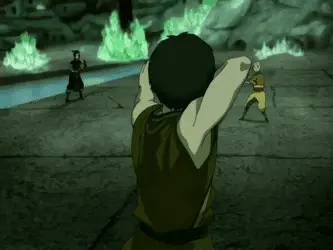
Only he doesn’t. He chooses the darker path and helps Azula nearly kill Aang.
Kylo’s path never takes a lighter path like Zuko’s but he most certainly faces an internal struggle throughout both The Force Awakens and The Last Jedi. Especially in The Last Jedi, in the aftermath of murdering his father and his newfound connection to Rey. While he maintains a loyalty to his master, there’s no question of the conflict within him or the potential to travel down two separate paths.
When the moment comes, like Zuko, Kylo’s previous goals and motivations are simply too strong and win out in the end.
It’s more than just this shared plot point and the similarities of the two characters. It’s astounding just how similarly ATLA and The Last Jedi build towards these moments. Both very well function as a crossroads of destiny. They bring their characters together towards a single epic moment of conflict; literally, as in both cases the characters were quite separated at the time. While “Crossroads of Destiny” brings everyone basically together at the beginning, The Last Jedi splits them up for most of the movie.
Both the episode and movie even have a manipulative force arranging the tests of faith for Zuko and Kylo Ren. Azula invites Iroh and Zuko to the Earth King’s palace and uses a captive Katara to lure Aang and company. Snoke creates the connection between Rey and Kylo that convinces Rey of Kylo’s possible redemption, which is the main reason Rey surrenders herself over.
Azula and Snoke both create the test facing the antagonist so they can stack the odds in their favor. To wildly different results, of course; Azula is one of the greatest villains in animated history, if not all entertainment, while Snoke…well, don’t flatter him. He was never even a player. The point still remains.
Rian Johnson clearly watched ATLA before writing this movie.
It’s not just the similarities of the events. Both stories feature similar plots of a small resistance fighting an empire, and you can expect some natural overlap in the events. No, the resemblance goes much deeper, into the themes present throughout both and the driving motivations of their characters. They create and subvert expectations for their characters in much the same way and occur at stunningly similar points in the overall narrative.
Watching The Last Jedi was like watching all these episodes of ATLA mashed into a single cohesive runtime. Both feature the strain upon the personal and political relationships of the heroes created by remarkably similar threats. They build their story upon the comparison and contrast of the main protagonist and antagonist, culminating in a scene testing the loyalties of the antagonist.
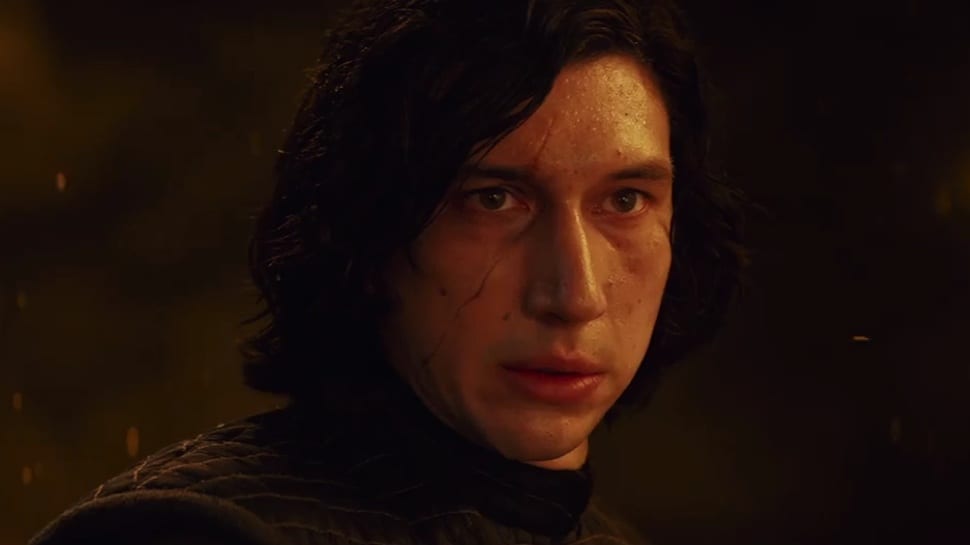
And both Zuko and Kylo Ren made the same choice to side with their lesser nature, leaving both stories in much the same place following the middle chapter. The heroes have suffered losses but continue to fight another day. The main antagonist has chosen their path but failed to erase the conflict inside them. So where does the story head from here?
For that, we may have to switch over to the other Avatar show.
The Legend of Rey
The biggest failing in this comparison definitely occurs between Aang to Rey. Where Aang avoids, Rey confronts. Where one dislikes the burden of their role, the other embraces it. If anything, Luke is the Last Airbender of The Last Jedi. He’s Aang and Tenzin both; the long lost symbol of hope the world still looks to as well as an heir struggling to stack up to a powerful legacy. He’s the mentor to the next generation and the hero that created the world as we see it. Luke is both youthful hero and jaded veteran both, struggling to handle his guilt until someone comes along as the moral center to inspire him.
No, Rey is no Aang. She’s a bright-eyed, determined hero with a strong sense of justice, a fierce temper, a craving to find her place and potential in the larger world, and a seeming aversion for sleeves. In short, Rey is Avatar Korra, and that raises some very interesting questions about the final film in this trilogy.
Namely, will we head for Harmonic Convergence, Balance, or both? Book 2, or Book 4?
The comparisons to both are pretty tasty. In the aftermath of The Last Jedi, I was reminded quite a bit of the setup for Book 4 of LoK. Snoke is the Earth Queen. Kylo Ren is Kuvira stepping into the power void. Rey obviously steps in as Korra, trying to find her place in the world and facing an adversary serving as both a parallel and foil. Add in the prominent theme of balance throughout The Last Jedi, which promises to find some new way for Force users in the final film of the trilogy separate from the Jedi and Sith, and was also the freaking name of LoK’s Book 4.
Or maybe we’ll go for Book 2 instead?
Book 2 was the season of Korra that, despite all its numerous flaws, really paved the new way for Korra separate from its predecessor show. It was the one where Korra lost her connection to her past lives and became the first Avatar of a new cycle. She literally shed her connections to her power as it had always been and began to move forward with her own identity.
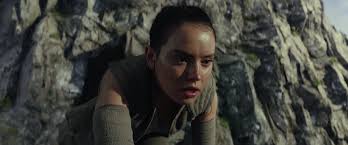
Rey stands in a very similar position right now. She spent the majority of The Last Jedi trying to learn from her Tenzin (BTW, Rey and Luke was everything Korra/Aang interactions should have been). Through this learning process and the events forcing her into action, she began discovering her own way. Now she’s on her own. Luke has vanished into the Force, like Korra’s past lives were erased. This is now her resistance and her story. This trilogy should end with her leading the universe into a new “spiritual age” the way Korra led her world.
And on a more thematic level, much like LoK fully separated from its past, The Last Jedi has put Star Wars in a position to break from the expectations and characters of the series. Gone are Luke Skywalker and Han Solo. Leia will soon follow (sorry, still crying). New heroes are leading the charge towards the future of Star Wars.
Does that mean it will have no connection to the past? Of course not. After all, for all the paradigm breaking LoK did, it still brought back fan favorites like Zuko and Toph. Still, Book 2 was the spark that gave LoK its own identity and allowed the show to move forward into a better future. Episode IX has the same chance now for Star Wars.
Will it actually go in this direction? It’s hard to tell. I’d have more confidence if Rian Johnson was returning to direct the end of the trilogy. Maybe he’ll take the series in this direction when he gets a hold of his own trilogy. I’m not sure JJ Abrams or LucasFilms will commit to this new direction, especially in the aftermath of the backlash against The Last Jedi.
Maybe we could send Abrams Legend of Korra: The Complete Series? I’ll put up money for that.

